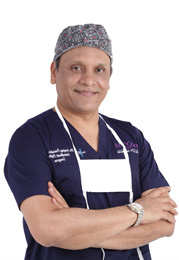Bed Sore Reconstruction
Bed sores are also known as pressure sores and pressure ulcers. These can be seen as damage to the skin and sub cutaneous tissue which is the result of prolonged pressure on the skin. Bedsores are mostly seen in the hips, tailbones, ankles, etc. These parts of the body are distinctly bony areas covered with skin. People who are bedridden or too weak to change positions on their own are at most risk of bedsores. Bedsores develop fast and are quite complex to treat effectively. It is better to prevent bedsores than to let them develop and require treatment.
What are the signs and stages of Bed Sores?
Bedsores are classified into 4 main stages, according to their severity.
Stage 1
The initial stage of bed sore shows the following characteristics:
- Skin is not punctured
- Reddish skin in light complexioned people
- Discolored skin on dark complexioned people
- Site appears painful, tender, warm, soft or cool in comparison to surrounding skin
Stage 2
In the second stage of classification, bedsores cause:
- Loss of/damage to outer skin and marginal damage to underlying tissue
- Shallow wound
- Pinkish/reddish in color
- Wound to become a blister
Stage 3
At the third stage of classification, bedsores show:
- Loss of skin exposing fat
- Deep ulcer
- Yellowish dead tissue at the bottom of wound
- Damage is deeper than the initial wound
Stage 4
At the fourth stage, bedsores cause significant loss of tissue:
- Wounds expose inner tendons, muscles and even bones
- Yellowish and crusty dead tissue is formed at the bottom of the wound
- Damage is deeper than the initial wound to the inner layers of skin
Un-stage able
In case a bed sore is covered with yellowish or dark brown dead tissue it is difficult to tell how deep the damage is beneath the crust.
Deep tissue Injury
Deep tissue injury is seen as:
- Purple/maroon unbroken skin
- Bloody blister
- Pain
- Skin is firm or soft
- Comparatively cooler or warmer than surrounding healthy skin
- Dark skin tone displays a shiny patch with changed skin tone
Where do Bed Sores develop?
Bedsores are seen developing in several places, such as:
For people who are mainly confined to a wheelchair, the bedsores are mostly seen in:
- Buttocks/tailbone
- Spine
- Shoulder blade
- Back of arms
- Behind the legs
For people who are bedridden, the bedsores are mostly seen developing in:
- Side/back of head
- Rim or ears
- Shoulder blades
- Shoulders
- Lower back
- Hips
- Tailbone
- Heels
- Ankles
- Back of knee
In case any of these signs are seen, it is advised to seek proper medical attention as soon as possible to prevent the ulcers from worsening.
What causes Bed Sores?
Bedsores are caused when constant pressure against skin on any part of the body results in obstruction of normal blood flow to the skin and underlying tissues in that part. Limited mobility and vulnerability of skin to excessive damage also cause bedsores.
The three main causes of bedsores are:
- Constant pressure: When the skin and underlying tissues become sandwiched between a surface and the bones (such as in bed or wheelchair) the blood flow in the finer blood vessels (capillaries) gets restricted. This causes less nutrition and oxygen being transferred to these tissues. Continued deprivation of oxygen and nutrients due to lack of proper blood supply in the capillaries results in skin cells dying and damage to the skin. This is caused mainly in areas that have very less muscle or fat cover between the bones and the skin. These are areas, such as the shoulders blades, hips, heels, elbows, tailbone and spine.
- Friction: Friction is caused when the skin resists motion of another surface which is in contact with it. This may result as the cause of the skin being dragged across a surface (while changing positions). In case the skin is already moist the friction makes the damage more severe.
- Shear: Shear is seen when the skin and the surface in contact with it move in opposite direction. This can occur with elevated bed. This motion may result in injuring the tissue and make the skin extra vulnerable to damage.
How is Bed Sore Reconstruction procedure performed?
- In case the bedsores are of the latter stages (Stages 3 and 4) then the doctor may advise surgical reconstruction to repair the extensive damage from the wound. The flap reconstruction is most common surgical treatment of bedsores.
- The surgical procedure requires sourcing healthy skin and muscle from a donor area and covering the open wound with the harvested tissue. Cosmetic surgeons are well-trained to handle this surgical reconstruction treatment effectively.
- Bedsores are common problems amongst the invalid and the severely disabled, and even for people recuperating in beds or wheelchairs. In case bedsores get severe it is advised to take medical help and get effective bedsore reconstruction treatment.
Bed sores are also known as pressure sores and pressure ulcers. These can be seen as damage to the skin and sub cutaneous tissue which is the result of prolonged pressure on the skin.




